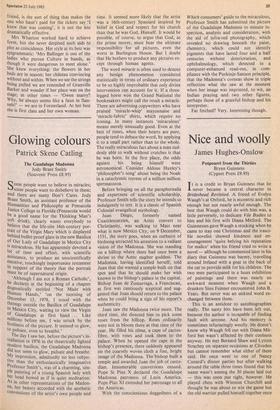Glowing colours
Patrick Skene Carling
The Guadalupe Madonna Jody Brant Smith (Souvenir Press £8.95)
Some people want to believe in miracles; some people want to disbelieve in them; and there are many Don't Cares. Jody Brant Smith, an assistant professor of the Humanities and Philosophy at Pensacola Junior College in Florida (Pensacola would be a good name for the Thinking Man's soft drink), clearly wants everybody to believe that the life-size 16th-century por- trait of the Virgin Mary which is displayed behind bullet-proof glass in the new Basilica of Our Lady of Guadalupe in Mexico City is miraculous. He has apparently devoted a lot of time and effort, with scientific assistance, to produce an unscientifically emotive, touchingly importunate testament in support of the theory that the portrait must be of supernatural origin.
'Although I am not a Roman Catholic', he declares at the beginning of a chapter dogmatically entitled Not Made with Human Hands,' on the morning of December 13, 1978, I stood with the throngs outside the Basilica of Guadalupe in Mexico City, waiting to view the Virgin of Guadalupe at first hand ... Like millions before me, I was struck by the liveliness of the picture. It seemed to glow, to pulsate, even to breathe.'
The day I saw her, before the picture's in- stallation in 1976 in the theatrically lighted modern basilica, the Guadalupe Madonna did not seem to glow, pulsate and breathe. MY impression, admittedly no less subjec- tive than the enthusiastically imaginative Professor Smith's, was of a charming, sim- ple painting of a young Spanish lady with her head bowed as if in quiet meditation. As in other representations of the Madon- na, her beauty accorded with the aesthetic conventions of the artist's own people and
time. It seemed more likely that the artist was a 16th-century Spaniard inspired by belief in God and respect for his church than that he was God, Himself. It would be possible, of course, to argue that God, as the prime mover, must bear the ultimate responsibility for all pictures, even the worst in Burlington House. But I doubt that He bothers to produce any pictures ex- cept through human agents.
The word miracle is often used to denote any benign phenomenon considered
statistically in terms of ordinary experience to be so highly improbable that only divine intervention can account for it. If a three- legged horse won the Grand National the bookmakers might call the result a miracle. There are advertising copywriters who have praised 'miracle-whip' mayonnaise and 'miracle-fabric' shirts, which require no ironing. In many instances 'miraculous' means merely unusually good. Even at the best of times, when their hearts are pure, people tend to debase the word, by applying it to a small part rather than to the whole. The really miraculous fact about a man sud- denly able to walk without crutches is that he was born. In the first place, the odds against his being himself were astronomical. Consider Aldous Huxley's 'philosopher's song' about being the Noah in a cataclysmic torrent of a million million spermatozoa.
Before bringing on all the paraphernalia and expertness of scientific scholarship, Professor Smith tells the story he intends so indulgently to test. It is a classic of Spanish Colonial evangelical mythology.
Juan Diego, formerly named Cuatitletoatzien, an Aztec convert to Christianity, was walking to Mass near what is now Mexico City, on 9 December, 1531, the story goes, when an outburst of birdsong attracted his attention to a radiant vision of the Madonna. She was standing on a hilltop where there had once been a shrine to the Aztec mo,ther goddess. The Madonna, having identified herself, told Juan that she wanted a temple built on that spot and that he should make her wish known in the bishop's palace in the capital. Bishop Juan de Zumarraga, a Franciscan, at first was cautiously sceptical and sug- gested that Juan should return to the palace when he could bring a sign of his report's authenticity.
Juan saw the Madonna twice more. The third time, she directed him to pick some roses from the hilltop. Roses ordinarily
were not in bloom there at that time of the year. He filled his tilma, a cape of cactus-
fibre, with roses and took them to the palace. When he opened the cape in the bishop's presence, there suddenly appeared on the coarsely woven cloth a fine, bright image of the Madonna. The bishop built a temple and awarded Juan the job of custo- dian. Innumerable conversions ensued. Pope St Pius X declared the Guadalupe Madonna patroness of Latin America. Pope Pius XI extended her patronage to all the Americas.
With the conscientious doggedness of a
Which consumers' guide to the miraculous, Professor Smith has submitted the picture of the Guadalupe Madonna to minute in- spection, analysis and consideration, with the aid of infra-red photography, which revealed no drawing beneath the paint, chemistry, which could not identify pigments that have lasted four and a half centuries without deterioration, and ophthalmology, which detected in a computer-enhanced read-out, in com- pliance with the Purkinje-Sanson principle, that the Madonna's corneas show in triple reflection what she saw at the moment when her image was imprinted, to wit, an Indian praying and two other figures, perhaps those of a grateful bishop and his interpreter.
Far fetched? Very. Interesting though.






































 Previous page
Previous page